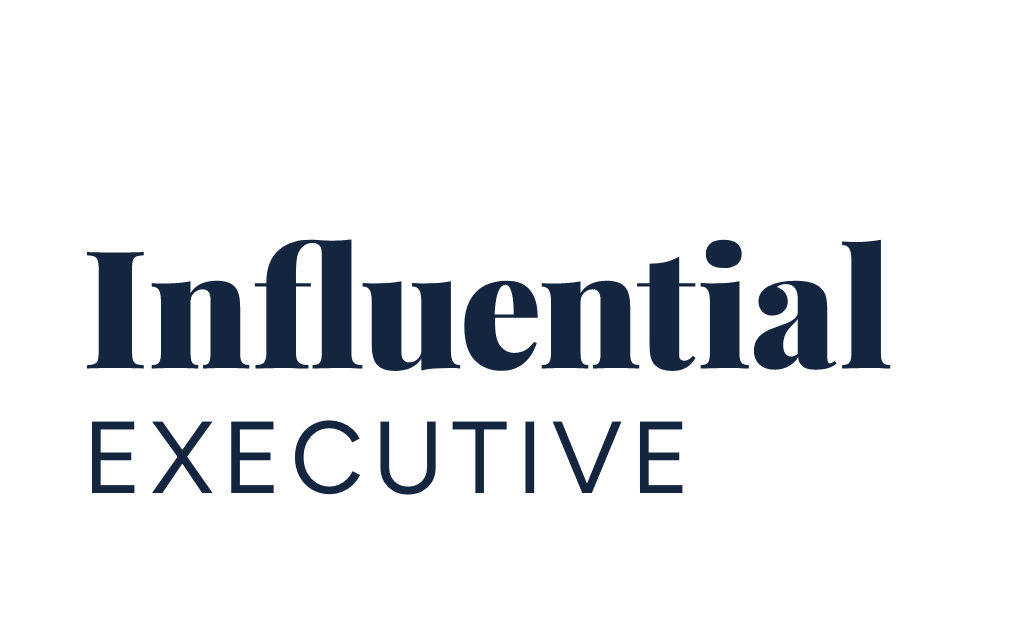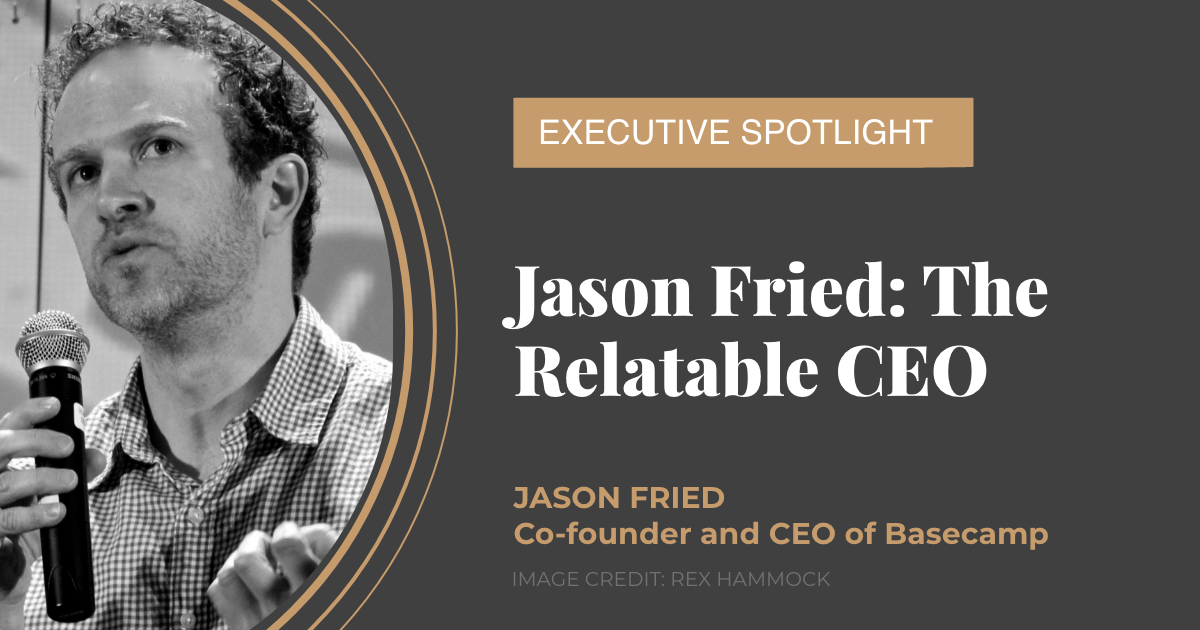“The higher up you go in an organization, the less you actually know about how the organization *actually* runs. And the CEO is always the last to know.” This type of candidness is what you can expect from Jason Fried, the co-founder and CEO of Basecamp. He is not one to mince words, whether it is in his articles about changing business culture, or his tweets criticizing the tech industry having “more worst practices than best practices.”
His opinions on how to organize workflow, how projects should be managed, and emphasizing better, ethical business practices neatly ties into the Basecamp brand. At its core, Basecamp is a project management software that emphasizes organization and efficiency in an effort to keep tasks on track. It streamlines communication to increase productivity and helps make projects more manageable. Basecamp is aimed toward businesses that are finding themselves taking on more and more projects but are finding other project management systems lacking, such as Slack, Asana, and email.
The cohesiveness of Fried’s social media accounts is not only strong thematically across his Twitter and LinkedIn profiles, but also ties back to Basecamp in an authentic way.
Building A Cohesive Social Media Ecosystem
The content across his LinkedIn and Twitter accounts are, for the most part, similar. Fried’s LinkedIn account is more focused on sharing business-related resources, books, and other media, especially content he has created or was a part of.
On the other hand, his Twitter account is more opinion-based, featuring more of his personal thoughts on the culture of running a business and his opinions on the general workplace environment. Whether he is sharing or retweeting posts or posting original content, the content across the two platforms are relevant to his passions and relate to Basecamp in different, though equally effective, ways.
For instance, many of his posts redirect to Signal V. Noise, Basecamp’s blog. It features a collection of articles on general business practices, emerging technology, and the product itself. This ties his social media accounts to the company without coming across as overly promotional.
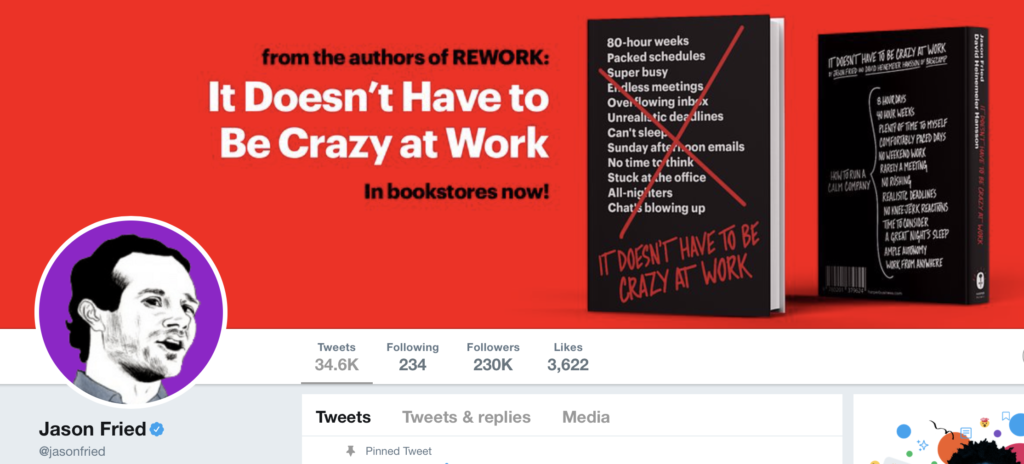
[Source]
His Twitter profile in particular has more of a personal touch than his LinkedIn, featuring a banner of his latest book, It Doesn’t Have To Be Crazy At Work. This is not only an effective way to let the audience know about his other projects, but also strengthens and legitimizes his position as someone who is passionate about changing inefficient workplace culture. The color scheme is minimalist, but effective: the simple bright red captures our attention, the black book stands out, and the large red “X” tells us everything we need to know about how Fried feels about 80-hour work weeks and endless meetings.
A Relatable Approach
Unknowns first. Saving big unknowns until later is a recipe for overruns, late projects, and declining morale. Late begets late. “If it’s late, what’s a little later?” Danger zone. If you’re going to punt anything, punt knowns, not unknowns. https://t.co/zxxxMe0h7P
— Jason Fried (@jasonfried) September 30, 2019
Fried effectively addresses common business issues while bringing it back to Basecamp and how its features solve these problems. A clear strength of Fried’s social media usage is that his posts are worded in a way that does not come across as a blatant advertisement, but rather as legitimate solutions. For example, in the tweet above, he does not make any reference to Basecamp as an actual product, but adds the link there as a way to redirect the user to the product’s feature list.
Fried is able to empathize with fellow business owners and put himself in their shoes, which allows him to put into words what struggling business owners are feeling:
You don’t always get to choose what you work on, but you can choose how you work on it. Scattered, haphazard, disorganized, chaotic, rushing, and decentralized. Or organized, together, coordinated, clear, calm, and all-in-one. You’ll find the latter at https://t.co/2spclJTKZ9.
— Jason Fried (@jasonfried) June 26, 2019
Rarely does Fried end his tweets with a call to action, but when he does, it reads as an organic solution to the problem presented, rather than an advertisement. Here is an example:
“How’s it going?” “Where we at?” “Are we going to get it done in time?” Sick of being asked (or asking)? You need Hill Charts. Here’s how you can provide status without being asked (or asking): https://t.co/ftppfC8qB7
— Jason Fried (@jasonfried) August 8, 2019
Even though he calls attention to Basecamp, the link does not lead to the product page or pricing plan. Instead, it links to Shape Up, a free book that reinforces both Fried’s business ideologies and reiterates Basecamp as the perfect solution.
In the previous two examples, Fried uses lists or questions as effective methods to engage with the user and make them think about their own obstacles at work, but sometimes less is more, like in this tweet:
Bets, not backlogs. https://t.co/ggYC0aPN5i
— Jason Fried (@jasonfried) July 31, 2019
Fried often uses language that is thought-provoking, rather than aggressively calling on the reader to click a link. Shorter posts such as these can often be just as effective since it makes the audience curious about the context and what he really means.
Across his tweets, Fried maintains a consistent tone of voice, often saying things that employees are feeling but cannot put into words. In this way, his social media posts do not just resonate with CEOs and company leaders, but with employees as well.
“It’s late” is rarely because there wasn’t enough time.
— Jason Fried (@jasonfried) September 30, 2019
“Crunch time” isn’t about a lack of time, it’s about unreasonable expectations. Another two weeks won’t solve that. Neither will another month.
— Jason Fried (@jasonfried) September 30, 2019
At times, he injects a sense of humor into his tweets, but always maintains a straightforward tone of voice when highlighting the issue:
Being an Authentic and Transparent CEO
His social media posts are so effective because he is able to condense his opinions into short tweets, while simultaneously being straightforward to the reader. Going back to the quote at the beginning of the article, it is rare to find this level of candidness among CEOs, one who openly admits that even the leader of a company may not know everything that is happening within the company. It is a far cry from leaders that micromanage and believe they have a finger on the pulse of everything going on.
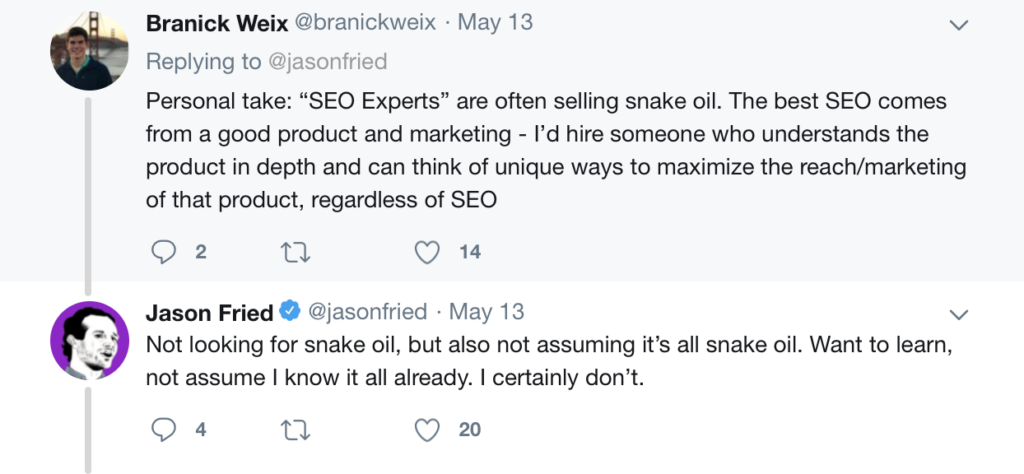
[Source]
Fried is passionate about his opinions and while he can sometimes come off as blunt, it never comes across as fake or scripted. He is willing to engage with his audience to defend his position, and always does so directly but always tactfully.
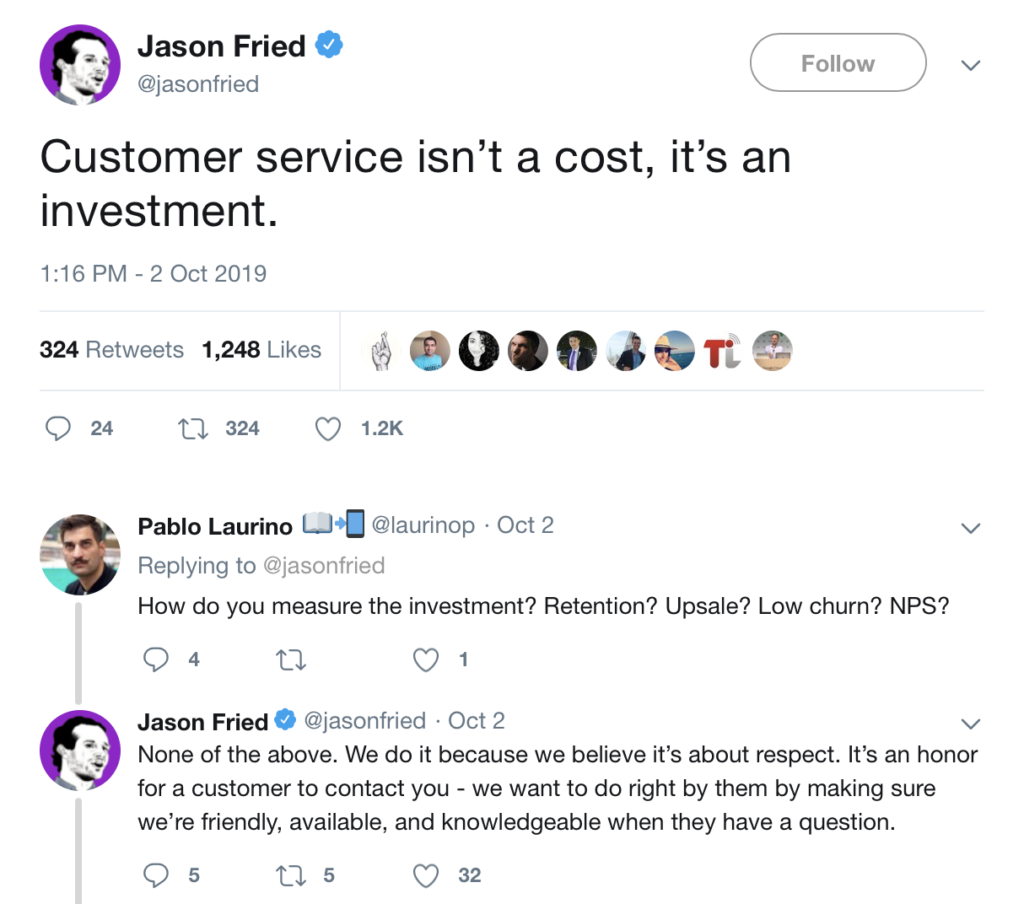
[Source]
Part of his authenticity also stems from his eagerness to engage with his audience on social media. Not only is he responsive on Twitter in particular, he takes part in many AMAs (“ask me anything”) and uses his Twitter and LinkedIn profiles to promote these sessions:
Got some great questions coming in. Thanks everyone! Let’s try to get 50 more questions and then we’ll start answering! https://t.co/k5mXykxIIp
— Jason Fried (@jasonfried) September 30, 2019
One of his upcoming projects on YouTube is “Unactionable Advice,” a series of videos that will be formatted in an AMA format. Across his social media accounts, he is very open to sharing his opinions and conversing with his audience, especially given how passionate he is about the topics.
Being a “hands-on” type of CEO is important to Fried and this is another common theme commonly seen across his social media profiles. It is not just general workplace culture he wants to improve, but also his own product. In one tweet, he made it clear the opinions of Basecamp’s user base was important to him. He printed out their comments, stating all of the feedback measured over 100ft long.
Printed out, our “What changed for the better since you switched to Basecamp” page would stretch well over 100 ft (33 m)… That’s a lot of better —> https://t.co/Zqn4REQPss pic.twitter.com/j01n9demqo
— Jason Fried (@jasonfried) September 20, 2019
This ties into another reason why the content on his social media profiles is compelling: his posts relating to Basecamp are never promotional, but rather focus on evoking an emotional response from the audience. These posts generally do not have a direct call to action that prompts the reader to click the link, but are nonetheless effective in getting them to click the link he ends with.
Fried maintains a persona of being an approachable, engaged CEO. He shows that his product has positively changed many workplaces in a way that comes across as genuine. It is a more sincere way of promoting his product since it is not really him that is saying Basecamp is great, but the actual users.
We asked our customers what work was like before they used Basecamp. And how it’s improved after switching to Basecamp. Thousands replied. Turns out, it’s night and day. Read some short stories —> https://t.co/keEbLkCkSy
— Jason Fried (@jasonfried) September 11, 2019
His social media posts often have a holistic approach for businesses as a whole, rather than just for CEOs or employees. It is not just internal business culture that Fried is passionate about, but also how businesses treat their employees and customers. For example, in these tweets, Fried wants to change the way businesses address consumers, saying there needs to be a shift away from violent, war-inspired language:
Enough with using “capture” in a business context. Capturing market share, capturing customers, capturing value. Stop! Capture is such a violent, one-sided term with zero regard for the captured. What customer *wants* to be captured? Value can’t be “captured”.
— Jason Fried (@jasonfried) October 2, 2019
Another one that needs to stop: Blast. Email blast. Blasting customers. Who wants to be blasted with anything?
— Jason Fried (@jasonfried) October 2, 2019
Fried uses social media to shed light on all aspects of running a business and his frank way of dismissing current commonplace practices in exchange for a more ethical, positive change is refreshing. Here are some examples:
Another thing we don’t track at Basecamp: Employees. There’s no “presence” at Basecamp. No available, no away, no busy. We simply assume you are doing your job and using your time wisely: https://t.co/QbJipoSsoA
— Jason Fried (@jasonfried) August 28, 2019
Can you tell I care a little too much about this stuff? Heated! But it’s so so important. The way you work has an enormous impact on how you feel about said work, and what you’re capable of sustainably producing. It really really matters. https://t.co/P83Fq2uW1Z
— Jason Fried (@jasonfried) August 2, 2019
It is clear Fried wants to use his social media platforms to enact positive changes within the work environment and encourage a new way of thinking. This means he is not afraid to call out other big companies, like Apple and Google.
Full segment from my @SquawkCNBC appearance this morning re: Google selling your trademarked brand to the highest bidder: https://t.co/27nliopBHh
— Jason Fried (@jasonfried) September 6, 2019
Speaking of unfairness around Google’s ad/search situation, check out this damning piece on Apple’s nasty practice of stacking the App Store deck in their favor. The part about tanking Spotify is mind blowing. This is what absolute power leads to —> https://t.co/eY0DAQDGIS
— Jason Fried (@jasonfried) September 9, 2019
Fighting for fair business practices and making sure all businesses have an even playing field are important issues for Fried. Moreso on Twitter than LinkedIn, he uses his social media platform to bring attention to unethical business practices that hurt smaller companies. Similarly, he also calls out companies when they engage in questionable practices against consumers.
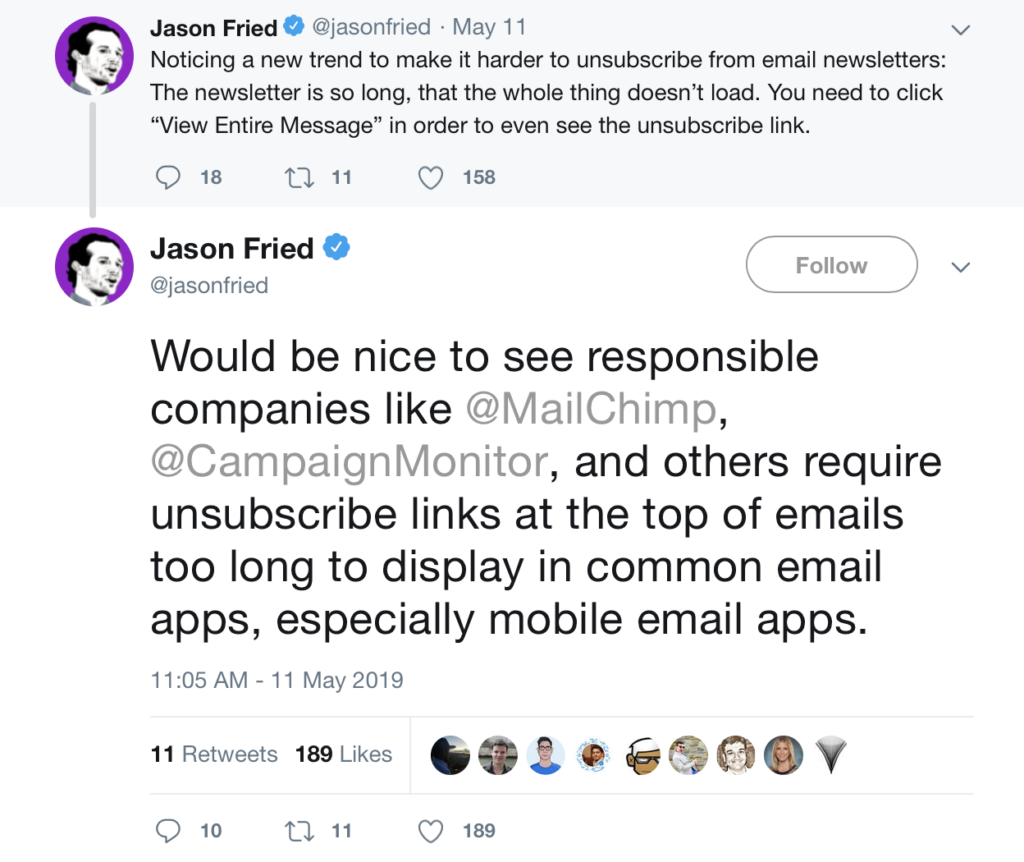
[Source]
Improvements
While Fried’s social media platforms have a strong theme connecting both of them and showcases how important positive and ethical business practices can be, there are some improvements that can be made.
Fried’s LinkedIn activity tends to be more sporadic compared to his recent Twitter activity. One way to maintain a consistent level of activity and tie his social profiles and Basecamp-related content together is to promote new Signal V. Noise articles on his LinkedIn account. Since Signal V. Noise is a part of the Basecamp branding, this would help strengthen his messaging on other channels while simultaneously building brand awareness.
On his LinkedIn profile, there is opportunity for Fried to add more personalization, especially to the header. Currently, it is just set to the default LinkedIn Banner. To unite his social media profiles visually, we recommend using a more personalized banner. Even using the same book banner from his Twitter profile could help build more cohesiveness between his social media platforms and serve as a way to promote his other work.
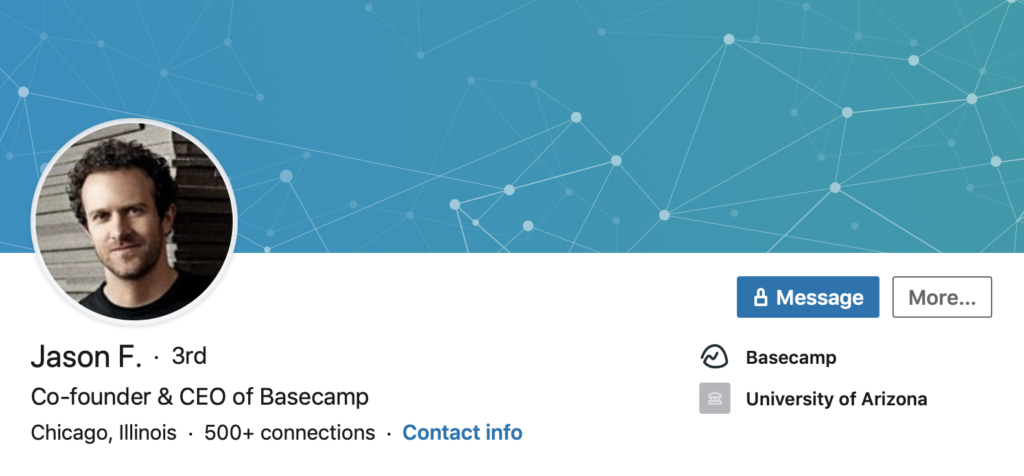
For Fried’s Twitter profile, while the header is visually effective, the image quality is low with pixelated and blurry sections around the text. We strongly recommend always using a high-quality image for social media profiles in order to achieve a credible presence.
For both Fried’s Twitter and LinkedIn, we also suggest implementing relevant hashtags into his posts to increase user engagement and post visibility.
Conclusion
In conclusion, Jason Fried’s social media profiles follow a consistent tone of voice that promotes the topics he is particularly passionate about. His posts on social media illustrate his passion for engaging in better business practices, whether it is directed toward the business owner, employees, or to the end-user.
Even though the topics he discusses often relate to his product, Basecamp, his posts are never overtly promotional. Instead, he has a natural way of tying his opinions back to his product in a way that is more authentic, which truly capitalizes on his unique status as a leader rather than a faceless brand.
For digital marketers who want to include their brand’s executives in their marketing strategy, we have a guide to help get your execs on social media. Click here to download our free resource!

